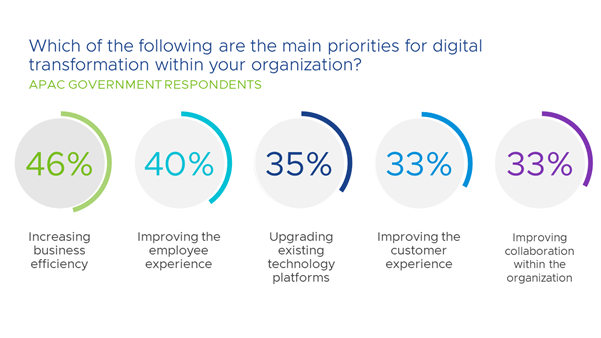[caption id="attachment_15503" align="alignright" width="150"] By Duncan Hewett, Senior Vice President and General Manager, VMware Asia Pacific and Japan[/caption]
By Duncan Hewett, Senior Vice President and General Manager, VMware Asia Pacific and Japan[/caption]
An enormous public health challenge put public-sector organizations under the microscope this year—including their policies, IT frameworks and ability to innovate. Citizens around the world look to their governments for clear communication, reassurance and leadership. This a critical time for strong government-citizen relations. With the speed of today’s media, people have more awareness of and ability to scrutinize their government’s crisis response in comparison to other countries.
Looking at how governments and public health organizations utilized applications during the pandemic is a good proxy in assessing how well they adapted to engage and support their citizens. Many make use of modern apps: multi-cloud supportive software services comprised of virtual machines, containers and serverless functionality. Through modern apps, they quickly adapt and launch services such as contact tracing, real-time hospital bed availability or pinpointing the location of the latest COVID-19 hotspots.
Take the example of South Korea, a region that showed technology leadership early. By mid-March, the government provided an open API to developers that contained the real-time sales data of face masks from 22,000 pharmacies nationwide, allowing citizens to check where stock was available. The South Korean government also made public health statistics available, so developers could create mobile apps to help track the spread of the disease.
What Makes Governments Successful at Rapid Response?
Governments with a modern digital infrastructure fared better at rapidly communicating, engaging and enabling their citizens in response to COVID-19. These countries, states and provinces built up their digital infrastructure to develop and modernize applications that can scale effortlessly through the cloud.
For governments, similar to large enterprises, this modernization is not often something that can be done quickly. (My colleague Bruce Davie explains this well in this article on technical debt.) In years prior, nascent markets in Asia leapfrogged straight to advanced technologies when embracing digital transformation. Today, those that already tapped into a modern digital infrastructure and leveraged available cloud services are now able to deliver new information or capabilities to citizens significantly faster.
Singapore is a good example of a roadmap for application modernization. Progressing on a five-year cloud migration, the city-state contracted new services that span a wealth of citizen services—including tax, smart water meters and even student exams—all designed to offer citizens a digital application experience. And in the context of COVID-19, this allowed for the rapid development of a contact tracing app, as well as a SafeEntry app that checks in every customer or visitor to a business.
It is amazing to see this in operation just about everywhere in Singapore. For a shop, restaurant or mall, it is as simple as displaying a sign with a QR code, and as a citizen, you simply scan the QR code (in most cases without even breaking stride) and walk through a temperature sensor. Genuine feedback from citizens is that they feel safer and more confident going about their daily lives.
This addresses a very important and timely need, and naturally digital transformation initiatives like these are not always as effective. As part of a wider study into digital transformation and application modernization, VMware and Vanson Bourne surveyed 235 government organizations globally. About 42% of respondents ranked improving the customer experience within their top three priorities, which shows how important effective communication is for governments. Interestingly, 37% of respondents said they will prioritize upgrading existing technology platforms, which will no doubt help them reach their goals.
How Can Governments Effectively Modernize Applications?
Here's what experts recommend. Focuse on the big picture. Do not modernize in isolation. Ensure there is still enough insight and investment to focus on continuous improvement.
I will add that:
- Having tech-minded leaders matters, a view supported by 78% of governmental respondents to our study.
- And one cannot underestimate the need to ensure teams have the skills needed to see the project through to its completion. About 95% of public service respondents also agree in our study.
- The final quality that organizations should develop is promoting an agile mindset amongst employees. Digital transformation is a movable beast and often requires teams to adapt quickly to changing circumstances.
This is a journey that Cenitex is on, a state-owned enterprise in Victoria, Australia. Cenitex intends to transform the end-user computing (EUC) experience for 35,000 civil servants and develop better public services for local citizens. They moved to a hybrid cloud approach for increased flexibility over service demand, and they adopted modern applications to manage digital workspaces. They now have a more resilient and secure service that makes it easier to adjust to unforeseen situations.
In the video above, hear more about the end-to-end IT infrastructure refresh at Cenitex. (Click "fullscreen" in the bottom-right corner to expand the video.)
I recently discussed this with the CEO, Frances Cawthra, and her leadership team. It’s impressive to hear what they achieved during this crisis. They went from running citizen services in five key buildings to operating from 5,000 civil servant homes—nearly a complete EUC transformation in just two weeks. Now, we know the preparation the team put in over the previous two-plus years to establish a resilient digital infrastructure was a lot of work, and COVID-19 was never planned. But their planning truly paid off.
Public-Private Partnerships Make a Difference
Public-sector innovation is important as the world increasingly adopts digital services. It is especially critical as unexpected events, like a pandemic, accelerate the need for massive digital transformation. Many Asia-Pacific governments collaborate with the private sector to bolster innovation and guide development of new and improved digital government services.
For example, look at Victor Dominello, minister for customer service at NSW government and a member for Ryde in Australia. He champions a new way to serve citizens: communication on bushfires, heightening cybersecurity and developing practical ways of carrying a digital license in the wake of COVID-19. Leadership like this is critical to the evolution of government communication and services.
This year, necessity has driven a true acceleration of digital services, be it for safety, providing medical services, rolling out stimulus packages or contact tracing. Governments' ability to scale business-critical apps, push updates and respond in real-time to feedback is imperative. That's how they deliver the best citizen experiences and reinforce safety and security.
The only change is that, following the pandemic, citizens will expect these digital services. Pressures to improve will not go away. By working together to modernize infrastructure and application delivery, governments and enterprises will be well placed to take advantage of the continuing shift to ubiquitous connectivity.


